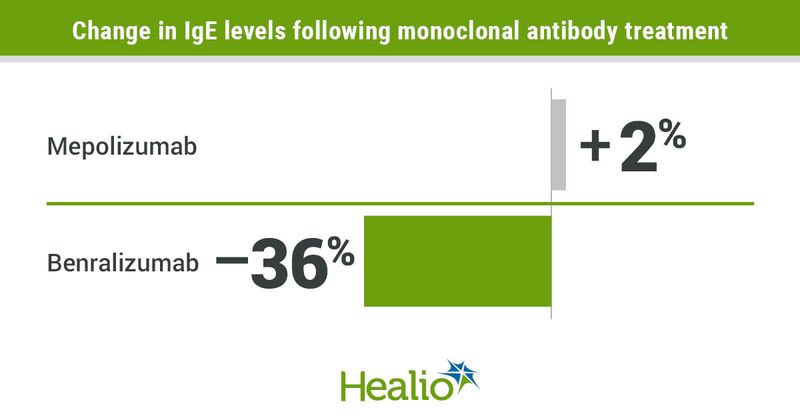Benralizumab outperforms mepolizumab in IgE reduction for severe eosinophilic asthma
Benralizumab reduced levels of IgE circulating in the blood among patients with severe eosinophilic asthma but mepolizumab did not, according to a study published in Clinical and Translational Allergy.
These humanized monoclonal antibodies inhibit eosinophil-driven inflammation, Marco Contoli, MD, PhD, associate professor in the section of respiratory medicine in the department of translational medicine at University of Ferrara in Ferrara, Italy, and colleagues wrote.

Mepolizumab (Nucala, GlaxoSmithKline) does so by blocking IL-5, whereas benralizumab (Fasenra, AstraZeneca) blocks one of IL-5’s receptors. Both improve quality of life and reduce oral corticosteroid use and exacerbation rates, according to the researchers.
As a pleiotropic molecule, IgE is a key inflammatory molecule in the T2 inflammatory cascade. It also is a modulatory molecule that is part of innate and adaptive immune systems.
The observational, retrospective, multicenter cohort study included 104 patients treated with mepolizumab (mean age, 57 years; 53% women; baseline IgE level, 387 ± 56 kU/L) and 82 patients treated with benralizumab (mean age, 56 years; 51% women; baseline IgE level, 384 ± 57 kU/L) for severe eosinophilic atopic asthma for an average of 3 months.
After 116 ± 3 days of treatment, the mepolizumab-treated patients had IgE levels of 404 ± 47 kU/L. The researchers said this 2% increase was not significant. IgE levels increased for 27% of these patients, were stable for 37% and went down for 35%.
But after 108 ± 4 days of treatment, the benralizumab-treated patients had IgE levels of 247 ± 35 kU/L, which the researchers deemed a significant reduction (–36%; P < .001). Overall, 92% of these patients demonstrated reductions in their IgE levels.
Both groups of patients also had similar levels of total blood leukocytes, blood lymphocytes, blood eosinophils and blood basophils at baseline. Although treatment did not affect blood lymphocyte or neutrophil levels in either group, both groups did show significant reductions in blood eosinophil counts, with the patients on benralizumab achieving significantly lower blood eosinophil levels than the patients receiving mepolizumab (P < .05).
Additionally, benralizumab reduced blood basophil counts by 78% after 108 ± 3 days while mepolizumab reduced them by 33% after 115 ± 3 days (P < .01). Also, benralizumab produced a significant reduction in levels of fractional nitric oxide concentrations in exhaled breath while mepolizumab did not (P < .05).
There were no correlations between IgE levels and blood eosinophil or basophil in either group at baseline or after treatment, although the researchers noted a significant positive correlation among patients receiving benralizumab between on-treatment reductions in IgE levels and reduced blood basophil levels (Spearman rank correlation = 0.34; P < .01), but not with eosinophil counts.
There were significant improvements in both groups in their pre-bronchodilator FEV1, with no correlations between changes in lung function and changes in blood IgE levels, the researchers wrote.
Both groups also had clinical improvements in their asthma control test (ACT) scores. The benralizumab-treated patients had a weak but statistically significant correlation between on-treatment changes in ACT scores and changes in IgE levels (Spearman rank correlation = –0.32; P < .05).
Similar treatment durations with these medications produced different effects on total blood IgE levels and blood basophils, the researchers concluded, with a correlation between these reductions and improved asthma control. Further, the researchers called for properly designed studies to assess the clinical impact of these findings.
